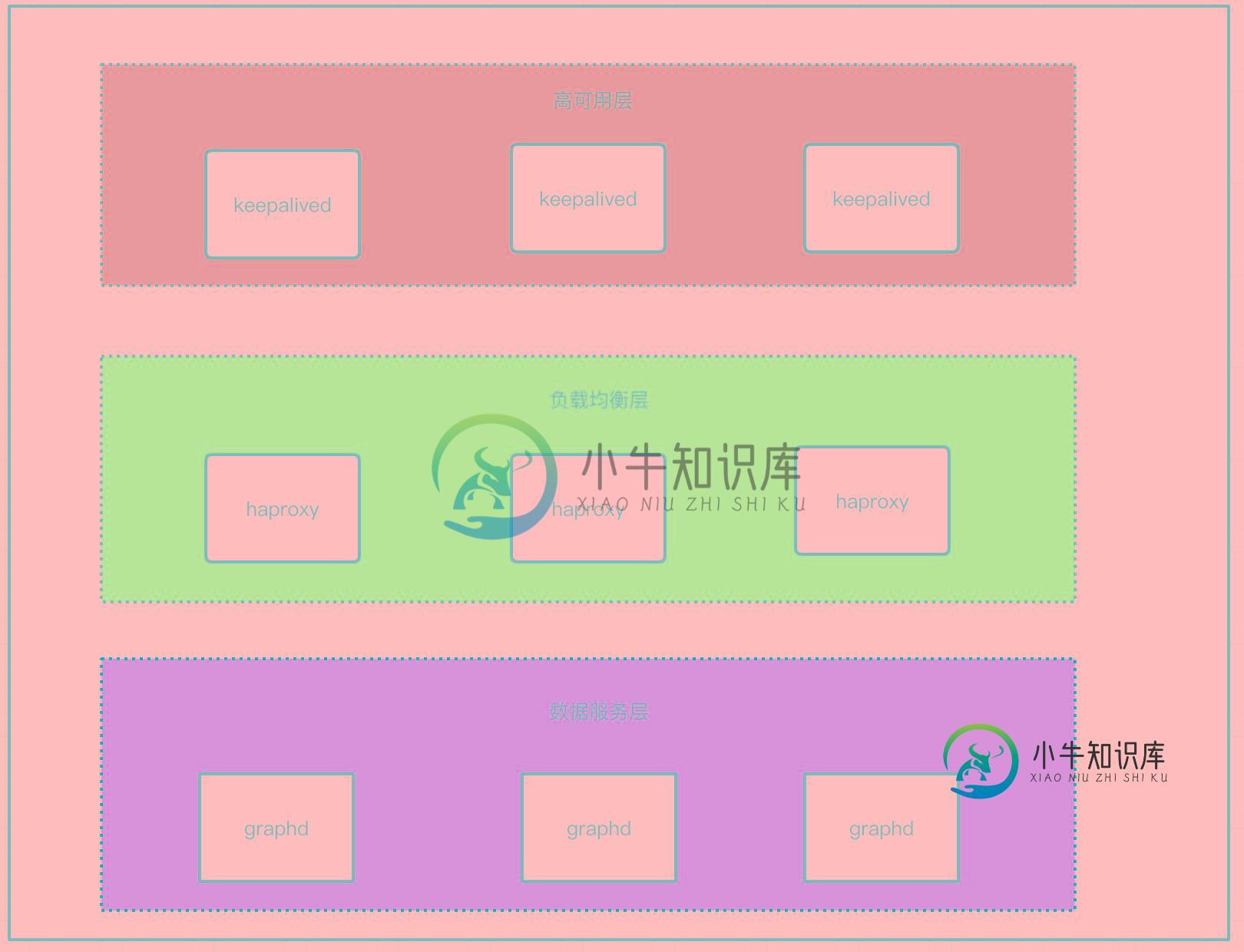用Docker swarm快速部署Nebula Graph集群的教程
一、前言
本文介绍如何使用 Docker Swarm 来部署 Nebula Graph 集群。

二、nebula集群搭建
2.1 环境准备
机器准备
| ip |
内存(Gb) |
cpu(核数) |
| 192.168.1.166 |
16 |
4 |
| 192.168.1.167 |
16 |
4 |
| 192.168.1.168 |
16 |
4 |
在安装前确保所有机器已安装docker
2.2 初始化swarm集群
在192.168.1.166机器上执行
$ docker swarm init --advertise-addr 192.168.1.166 Swarm initialized: current node (dxn1zf6l61qsb1josjja83ngz) is now a manager. To add a worker to this swarm, run the following command: docker swarm join \ --token SWMTKN-1-49nj1cmql0jkz5s954yi3oex3nedyz0fb0xx14ie39trti4wxv-8vxv8rssmk743ojnwacrr2e7c \ 192.168.1.166:2377 To add a manager to this swarm, run 'docker swarm join-token manager' and follow the instructions.
2.3 加入worker节点
根据init命令提示内容,加入swarm worker节点,在192.168.1.167 192.168.1.168分别执行
docker swarm join \ --token SWMTKN-1-49nj1cmql0jkz5s954yi3oex3nedyz0fb0xx14ie39trti4wxv-8vxv8rssmk743ojnwacrr2e7c \ 192.168.1.166:2377
2.4 验证集群
docker node ls ID HOSTNAME STATUS AVAILABILITY MANAGER STATUS ENGINE VERSION h0az2wzqetpwhl9ybu76yxaen * KF2-DATA-166 Ready Active Reachable 18.06.1-ce q6jripaolxsl7xqv3cmv5pxji KF2-DATA-167 Ready Active Leader 18.06.1-ce h1iql1uvm7123h3gon9so69dy KF2-DATA-168 Ready Active 18.06.1-ce
2.5 配置docker stack
vi docker-stack.yml
配置如下内容
version: '3.6' services: metad0: image: vesoft/nebula-metad:nightly env_file: - ./nebula.env command: - --meta_server_addrs=192.168.1.166:45500,192.168.1.167:45500,192.168.1.168:45500 - --local_ip=192.168.1.166 - --ws_ip=192.168.1.166 - --port=45500 - --data_path=/data/meta - --log_dir=/logs - --v=0 - --minloglevel=2 deploy: replicas: 1 restart_policy: condition: on-failure placement: constraints: - node.hostname == KF2-DATA-166 healthcheck: test: ["CMD", "curl", "-f", "http://192.168.1.166:11000/status"] interval: 30s timeout: 10s retries: 3 start_period: 20s ports: - target: 11000 published: 11000 protocol: tcp mode: host - target: 11002 published: 11002 protocol: tcp mode: host - target: 45500 published: 45500 protocol: tcp mode: host volumes: - data-metad0:/data/meta - logs-metad0:/logs networks: - nebula-net metad1: image: vesoft/nebula-metad:nightly env_file: - ./nebula.env command: - --meta_server_addrs=192.168.1.166:45500,192.168.1.167:45500,192.168.1.168:45500 - --local_ip=192.168.1.167 - --ws_ip=192.168.1.167 - --port=45500 - --data_path=/data/meta - --log_dir=/logs - --v=0 - --minloglevel=2 deploy: replicas: 1 restart_policy: condition: on-failure placement: constraints: - node.hostname == KF2-DATA-167 healthcheck: test: ["CMD", "curl", "-f", "http://192.168.1.167:11000/status"] interval: 30s timeout: 10s retries: 3 start_period: 20s ports: - target: 11000 published: 11000 protocol: tcp mode: host - target: 11002 published: 11002 protocol: tcp mode: host - target: 45500 published: 45500 protocol: tcp mode: host volumes: - data-metad1:/data/meta - logs-metad1:/logs networks: - nebula-net metad2: image: vesoft/nebula-metad:nightly env_file: - ./nebula.env command: - --meta_server_addrs=192.168.1.166:45500,192.168.1.167:45500,192.168.1.168:45500 - --local_ip=192.168.1.168 - --ws_ip=192.168.1.168 - --port=45500 - --data_path=/data/meta - --log_dir=/logs - --v=0 - --minloglevel=2 deploy: replicas: 1 restart_policy: condition: on-failure placement: constraints: - node.hostname == KF2-DATA-168 healthcheck: test: ["CMD", "curl", "-f", "http://192.168.1.168:11000/status"] interval: 30s timeout: 10s retries: 3 start_period: 20s ports: - target: 11000 published: 11000 protocol: tcp mode: host - target: 11002 published: 11002 protocol: tcp mode: host - target: 45500 published: 45500 protocol: tcp mode: host volumes: - data-metad2:/data/meta - logs-metad2:/logs networks: - nebula-net storaged0: image: vesoft/nebula-storaged:nightly env_file: - ./nebula.env command: - --meta_server_addrs=192.168.1.166:45500,192.168.1.167:45500,192.168.1.168:45500 - --local_ip=192.168.1.166 - --ws_ip=192.168.1.166 - --port=44500 - --data_path=/data/storage - --log_dir=/logs - --v=0 - --minloglevel=2 deploy: replicas: 1 restart_policy: condition: on-failure placement: constraints: - node.hostname == KF2-DATA-166 depends_on: - metad0 - metad1 - metad2 healthcheck: test: ["CMD", "curl", "-f", "http://192.168.1.166:12000/status"] interval: 30s timeout: 10s retries: 3 start_period: 20s ports: - target: 12000 published: 12000 protocol: tcp mode: host - target: 12002 published: 12002 protocol: tcp mode: host volumes: - data-storaged0:/data/storage - logs-storaged0:/logs networks: - nebula-net storaged1: image: vesoft/nebula-storaged:nightly env_file: - ./nebula.env command: - --meta_server_addrs=192.168.1.166:45500,192.168.1.167:45500,192.168.1.168:45500 - --local_ip=192.168.1.167 - --ws_ip=192.168.1.167 - --port=44500 - --data_path=/data/storage - --log_dir=/logs - --v=0 - --minloglevel=2 deploy: replicas: 1 restart_policy: condition: on-failure placement: constraints: - node.hostname == KF2-DATA-167 depends_on: - metad0 - metad1 - metad2 healthcheck: test: ["CMD", "curl", "-f", "http://192.168.1.167:12000/status"] interval: 30s timeout: 10s retries: 3 start_period: 20s ports: - target: 12000 published: 12000 protocol: tcp mode: host - target: 12002 published: 12004 protocol: tcp mode: host volumes: - data-storaged1:/data/storage - logs-storaged1:/logs networks: - nebula-net storaged2: image: vesoft/nebula-storaged:nightly env_file: - ./nebula.env command: - --meta_server_addrs=192.168.1.166:45500,192.168.1.167:45500,192.168.1.168:45500 - --local_ip=192.168.1.168 - --ws_ip=192.168.1.168 - --port=44500 - --data_path=/data/storage - --log_dir=/logs - --v=0 - --minloglevel=2 deploy: replicas: 1 restart_policy: condition: on-failure placement: constraints: - node.hostname == KF2-DATA-168 depends_on: - metad0 - metad1 - metad2 healthcheck: test: ["CMD", "curl", "-f", "http://192.168.1.168:12000/status"] interval: 30s timeout: 10s retries: 3 start_period: 20s ports: - target: 12000 published: 12000 protocol: tcp mode: host - target: 12002 published: 12006 protocol: tcp mode: host volumes: - data-storaged2:/data/storage - logs-storaged2:/logs networks: - nebula-net graphd1: image: vesoft/nebula-graphd:nightly env_file: - ./nebula.env command: - --meta_server_addrs=192.168.1.166:45500,192.168.1.167:45500,192.168.1.168:45500 - --port=3699 - --ws_ip=192.168.1.166 - --log_dir=/logs - --v=0 - --minloglevel=2 deploy: replicas: 1 restart_policy: condition: on-failure placement: constraints: - node.hostname == KF2-DATA-166 depends_on: - metad0 - metad1 - metad2 healthcheck: test: ["CMD", "curl", "-f", "http://192.168.1.166:13000/status"] interval: 30s timeout: 10s retries: 3 start_period: 20s ports: - target: 3699 published: 3699 protocol: tcp mode: host - target: 13000 published: 13000 protocol: tcp # mode: host - target: 13002 published: 13002 protocol: tcp mode: host volumes: - logs-graphd:/logs networks: - nebula-net graphd2: image: vesoft/nebula-graphd:nightly env_file: - ./nebula.env command: - --meta_server_addrs=192.168.1.166:45500,192.168.1.167:45500,192.168.1.168:45500 - --port=3699 - --ws_ip=192.168.1.167 - --log_dir=/logs - --v=2 - --minloglevel=2 deploy: replicas: 1 restart_policy: condition: on-failure placement: constraints: - node.hostname == KF2-DATA-167 depends_on: - metad0 - metad1 - metad2 healthcheck: test: ["CMD", "curl", "-f", "http://192.168.1.167:13001/status"] interval: 30s timeout: 10s retries: 3 start_period: 20s ports: - target: 3699 published: 3640 protocol: tcp mode: host - target: 13000 published: 13001 protocol: tcp mode: host - target: 13002 published: 13003 protocol: tcp # mode: host volumes: - logs-graphd2:/logs networks: - nebula-net graphd3: image: vesoft/nebula-graphd:nightly env_file: - ./nebula.env command: - --meta_server_addrs=192.168.1.166:45500,192.168.1.167:45500,192.168.1.168:45500 - --port=3699 - --ws_ip=192.168.1.168 - --log_dir=/logs - --v=0 - --minloglevel=2 deploy: replicas: 1 restart_policy: condition: on-failure placement: constraints: - node.hostname == KF2-DATA-168 depends_on: - metad0 - metad1 - metad2 healthcheck: test: ["CMD", "curl", "-f", "http://192.168.1.168:13002/status"] interval: 30s timeout: 10s retries: 3 start_period: 20s ports: - target: 3699 published: 3641 protocol: tcp mode: host - target: 13000 published: 13002 protocol: tcp # mode: host - target: 13002 published: 13004 protocol: tcp mode: host volumes: - logs-graphd3:/logs networks: - nebula-net networks: nebula-net: external: true attachable: true name: host volumes: data-metad0: logs-metad0: data-metad1: logs-metad1: data-metad2: logs-metad2: data-storaged0: logs-storaged0: data-storaged1: logs-storaged1: data-storaged2: logs-storaged2: logs-graphd: logs-graphd2: logs-graphd3: docker-stack.yml
编辑 nebula.env
加入如下内容
TZ=UTC USER=root
nebula.env
2.6 启动nebula集群
docker stack deploy nebula -c docker-stack.yml
三、集群负载均衡及高可用配置
Nebula Graph的客户端目前(1.X)没有提供负载均衡的能力,只是随机选一个graphd去连接。所以生产使用的时候要自己做个负载均衡和高可用。

图3.1
将整个部署架构分为三层,数据服务层,负载均衡层及高可用层。如图3.1所示
负载均衡层:对client请求做负载均衡,将请求分发至下方数据服务层
高可用层: 这里实现的是haproxy的高可用,保证负载均衡层的服务从而保证整个集群的正常服务
3.1 负载均衡配置
haproxy使用docker-compose配置。分别编辑以下三个文件
Dockerfile 加入以下内容
FROM haproxy:1.7 COPY haproxy.cfg /usr/local/etc/haproxy/haproxy.cfg EXPOSE 3640
Dockerfile
docker-compose.yml加入以下内容
version: "3.2" services: haproxy: container_name: haproxy build: . volumes: - ./haproxy.cfg:/usr/local/etc/haproxy/haproxy.cfg ports: - 3640:3640 restart: always networks: - app_net networks: app_net: external: true
docker-compose.yml
haproxy.cfg加入以下内容
global daemon maxconn 30000 log 127.0.0.1 local0 info log 127.0.0.1 local1 warning defaults log-format %hr\ %ST\ %B\ %Ts log global mode http option http-keep-alive timeout connect 5000ms timeout client 10000ms timeout server 50000ms timeout http-request 20000ms # custom your own frontends && backends && listen conf #CUSTOM listen graphd-cluster bind *:3640 mode tcp maxconn 300 balance roundrobin server server1 192.168.1.166:3699 maxconn 300 check server server2 192.168.1.167:3699 maxconn 300 check server server3 192.168.1.168:3699 maxconn 300 check listen stats bind *:1080 stats refresh 30s stats uri /stats
3.2 启动haproxy
docker-compose up -d
3.2 高可用配置
注:配置keepalive需预先准备好vip (虚拟ip),在以下配置中192.168.1.99便为虚拟ip
在192.168.1.166 、192.168.1.167、192.168.1.168上均做以下配置
安装keepalived
apt-get update && apt-get upgrade && apt-get install keepalived -y
更改keepalived配置文件/etc/keepalived/keepalived.conf(三台机器中 做如下配置,priority应设置不同值确定优先级)
192.168.1.166机器配置
global_defs {
router_id lb01 #标识信息,一个名字而已;
}
vrrp_script chk_haproxy {
script "killall -0 haproxy" interval 2
}
vrrp_instance VI_1 {
state MASTER
interface ens160
virtual_router_id 52
priority 999
# 设定MASTER与BACKUP负载均衡器之间同步检查的时间间隔,单位是秒
advert_int 1
# 设置验证类型和密码
authentication {
# 设置验证类型,主要有PASS和AH两种
auth_type PASS
# 设置验证密码,在同一个vrrp_instance下,MASTER与BACKUP必须使用相同的密码才能正常通信
auth_pass amber1
}
virtual_ipaddress {
# 虚拟IP为192.168.1.99/24;绑定接口为ens160;别名ens169:1,主备相同
192.168.1.99/24 dev ens160 label ens160:1
}
track_script {
chk_haproxy
}
}
167机器配置
global_defs {
router_id lb01 #标识信息,一个名字而已;
}
vrrp_script chk_haproxy {
script "killall -0 haproxy" interval 2
}
vrrp_instance VI_1 {
state BACKUP
interface ens160
virtual_router_id 52
priority 888
# 设定MASTER与BACKUP负载均衡器之间同步检查的时间间隔,单位是秒
advert_int 1
# 设置验证类型和密码
authentication {
# 设置验证类型,主要有PASS和AH两种
auth_type PASS
# 设置验证密码,在同一个vrrp_instance下,MASTER与BACKUP必须使用相同的密码才能正常通信
auth_pass amber1
}
virtual_ipaddress {
# 虚拟IP为192.168.1.99/24;绑定接口为ens160;别名ens160:1,主备相同
192.168.1.99/24 dev ens160 label ens160:1
}
track_script {
chk_haproxy
}
}
168机器配置
global_defs {
router_id lb01 #标识信息,一个名字而已;
}
vrrp_script chk_haproxy {
script "killall -0 haproxy" interval 2
}
vrrp_instance VI_1 {
state BACKUP
interface ens160
virtual_router_id 52
priority 777
# 设定MASTER与BACKUP负载均衡器之间同步检查的时间间隔,单位是秒
advert_int 1
# 设置验证类型和密码
authentication {
# 设置验证类型,主要有PASS和AH两种
auth_type PASS
# 设置验证密码,在同一个vrrp_instance下,MASTER与BACKUP必须使用相同的密码才能正常通信
auth_pass amber1
}
virtual_ipaddress {
# 虚拟IP为192.168.1.99/24;绑定接口为ens160;别名ens160:1,主备相同
192.168.1.99/24 dev ens160 label ens160:1
}
track_script {
chk_haproxy
}
}
keepalived相关命令
# 启动keepalived systemctl start keepalived # 使keepalived开机自启 systemctl enable keeplived # 重启keepalived systemctl restart keepalived
四、其他
离线怎么部署?把镜像更改为私有镜像库就成了,有问题欢迎来勾搭啊。

到此这篇关于用Docker swarm快速部署Nebula Graph集群的文章就介绍到这了,更多相关Docker 部署Nebula Graph集群内容请搜索小牛知识库以前的文章或继续浏览下面的相关文章希望大家以后多多支持小牛知识库!
-
本文向大家介绍使用docker快速部署Elasticsearch集群的方法,包括了使用docker快速部署Elasticsearch集群的方法的使用技巧和注意事项,需要的朋友参考一下 本文将使用Docker容器(使用docker-compose编排)快速部署Elasticsearch 集群,可用于开发环境(单机多实例)或生产环境部署。 注意,6.x版本已经不能通过 -Epath.config 参数
-
本文向大家介绍使用ruby部署工具mina快速部署nodejs应用教程,包括了使用ruby部署工具mina快速部署nodejs应用教程的使用技巧和注意事项,需要的朋友参考一下 前面有一篇文章讲到过用git的hook部署应用,hook的方法有一个缺陷就是每次都要到服务器去修改一下hook对应的配置文件,这个配置文件是与当前仓库分离的,调试上会有一些麻烦,借助ruby的一个部署工具mina可以快速的在
-
主版本和次版本升级 Seafile 在主版本和次版本中添加了新功能。有可能需要修改一些数据库表,或者需要更新搜素索引。一般来说升级集群包含以下步骤: 更新数据库 更新前端和后端节点上的符号链接以指向最新版本。 更新每个几点上的配置文件。 更新后端节点上的搜索索引。 一般来说,升级集群,您需要: 在一个前端节点上运行升级脚本(例如:./upgrade/upgrade_4_0_4_1.sh) 在其他所
-
按照Seafile 集群文档中给出的推荐架构,Seafile 集群需要使用一个分布式、高可用的数据库和缓存集群。在本文档中,我们给出一个在 3 台服务器上部署 MariaDB 和 Memcached 集群的案例。 硬件和操作系统需求 最少使用3台服务器部署来集群,每台机器都应该有: 2核、4GB内存。 1个SATA磁盘用来存储操作系统。 1个SATA磁盘用来存储MariaDB数据。也可以把 Mar
-
本系列文档介绍使用二进制部署最新 kubernetes v1.6.2 集群的所有步骤,而不是使用 kubeadm 等自动化方式来部署集群。 在部署的过程中,将详细列出各组件的启动参数,它们的含义和可能遇到的问题。 部署完成后,你将理解系统各组件的交互原理,进而能快速解决实际问题。 所以本文档主要适合于那些有一定 kubernetes 基础,想通过一步步部署的方式来学习和了解系统配置、运行原理的人。
-
本系列文档介绍使用二进制部署最新 kubernetes v1.6.2 集群的所有步骤,而不是使用 kubeadm 等自动化方式来部署集群。

